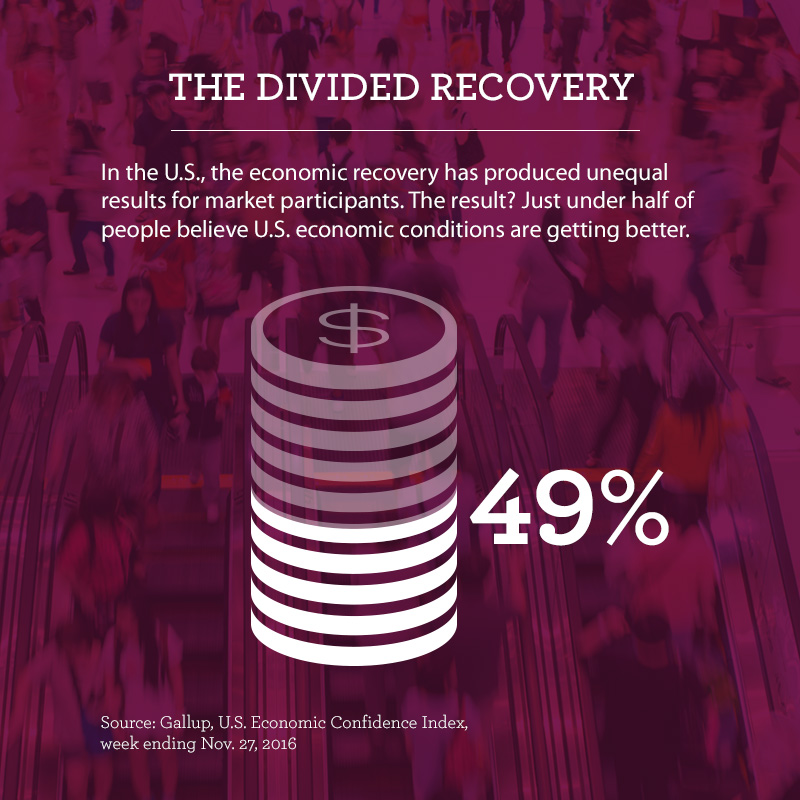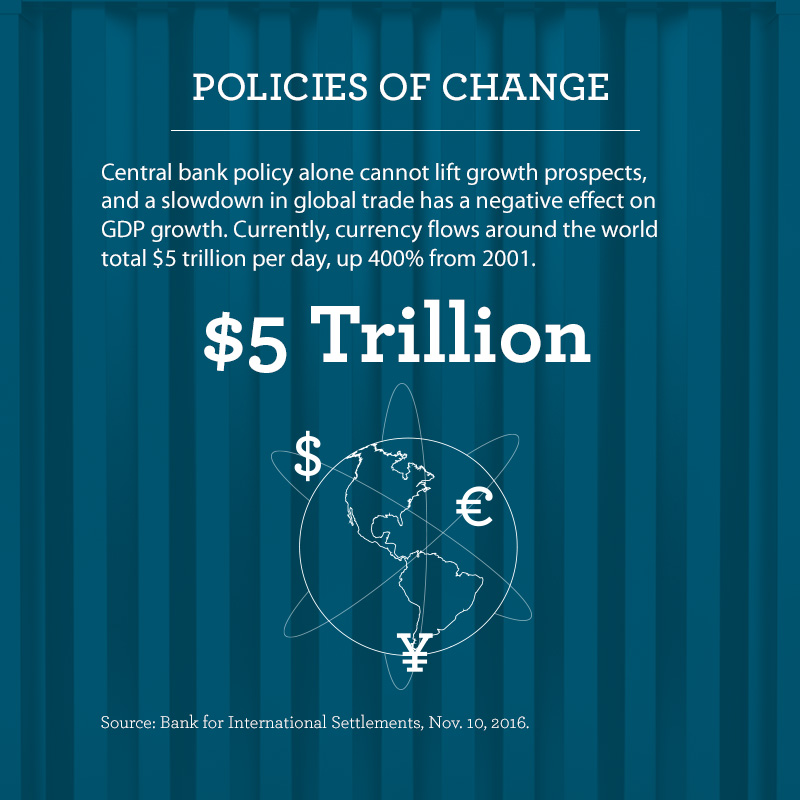



Wells Fargo Investment Institute is expecting improving growth, normalizing inflation, higher equity prices, and two interest rate hikes in 2017.
2.1%
U.S. Gross Domestic Product (GDP) growth
2.2%
U.S. inflation
2230–2330
S&P 500 Index
1.00%–1.25%
Federal Funds Rate
Investment and Insurance Products: NOT FDIC InsuredNO Bank GuaranteeMAY Lose Value
The last few years have, for the most part, been good for investors. But with the economic recovery heading toward its eighth anniversary in 2017, we see new global economic challenges and opportunities.
Click on any of these highlights to go to that section of the report for more information.
Five shifts, from the rise of the consumer in the United States to the impact of geopolitical events like Brexit, that will help shape 2017.
Will the market rise or fall? What will happen to interest rates? Our take on the economy and investment markets in the year ahead.
We’re keeping our eyes on the divided economic recovery and changing demographics and how they will impact the world.

In this video, Darrell Cronk, President of Wells Fargo Investment Institute, discusses five things that may impact the 2017 economic and investment outlook.
As we head into 2017, we are looking at the continuation of many trends, but we are starting to see things a little differently.
A solid labor market, improved consumer spending and housing activity, and modest recoveries in business inventories and investment spending should drive continued U.S. economic growth.
Past performance is no guarantee of future results.
Adjust handles to zoom in.
Sources: Federal Reserve System Flow of Funds Database, U.S. Bureau of Economic Analysis, and Wells Fargo Investment Institute, Oct. 25, 2016. Quarterly data and last point plotted is June 2016.
We are entering 2017 with a neutral equity stance compared to a year earlier. This is the first year of this market cycle for which we are not increasing our expectations for the year-end S&P 500 Index price/earnings valuation.
Past performance is no guarantee of future results. An index is unmanaged and not available for direct investment.
Adjust handles to zoom in.
Sources: Bloomberg, Wells Fargo Investment Institute, Sept. 30, 2016.
Our year-end target for the federal funds rate is 1.00%–1.25%. Longer-term yields will likely remain near current levels.
Yields represent past performance. Past performance is no guarantee of future results. Yields may be lower or higher than that quoted above. Yield will fluctuate as market conditions change.
*Series is a measure of expected inflation (on average) over the five year period that begins from that date. Source: Federal Reserve Board of St. Louis.
Adjust handles to zoom in.
Sources: Bloomberg and Wells Fargo Investment Institute, Nov. 28, 2016.
The 2017 outlook for commodities is a neutral position after decent price gains in 2016. Some individual commodities may be able to break away from the growth rates of the sector as a whole.
Data covers time period from Jan. 1, 2000 through June 30, 2016.
Past performance is no guarantee of future results. An index is unmanaged and not available for direct investment. Subsector levels represented by Bloomberg Commodity sub-indices.
Adjust handles to zoom in.
Sources: Bloomberg, Wells Fargo Investment Institute, June 30, 2016. Indexed to 100 as of 1/1/2000.
After a difficult start to 2016, alternative investment performance rebounded, and the landscape is potentially ripe with opportunities for strategies such as Equity Hedge and Relative Value.
Date ranges represent periods when the Federal Funds Rate was increasing.
Hedge Funds represented by the HFRI Fund Weighted Composite Index. Global Equities represented by the MSCI World Index. Bonds represented by the Bloomberg Barclays U.S. Aggregate Index. This information is for illustrative purposes only. It does not represent any specific investment or the experience of individual investors. Past performance is no guarantee of future results. An index is unmanaged and not available for direct investment.
Sources: MPI Stylus, Federal Reserve, June 30, 2016.
Alternative Investments, such as hedge funds and private capital funds, are only open to pesons who are “accredited investors” or “qualified purchasers” within the meaning of the U.S. securities laws. They trade in diverse complex strategies that are affected in different ways and at different times by changing market conditions. Strategies may, at times, be out of market favor for considerable periods with adverse consequences. You could lose all or a substantial amount of investment in these products.
Understanding where the economy and investment markets are headed is about looking deeply at the underlying trends. These four themes are influencing how we move forward.




Wells Fargo Investment Institute is home to more than 100 investment professionals focused on investment strategy, allocation, portfolio management, manager reviews, and alternative investments. For additional information on Wells Fargo Investment Institute, visit our website.
Click or tap ‘Download Report’ to get the full version of our 2017 Outlook.